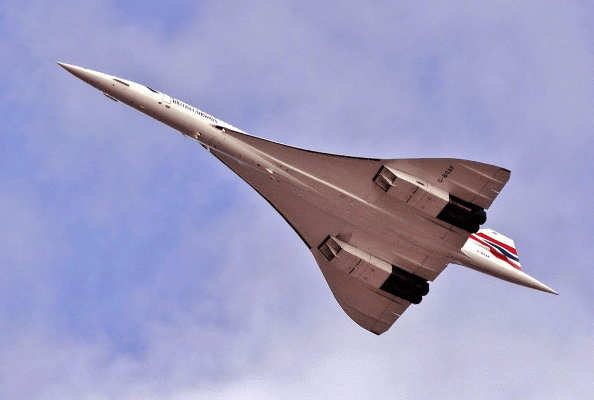110. British Aerospace/Aérospatiale Concorde
On this page:
Location: pier 86

Fast Facts
Concorde, the most extraordinary aircraft ever used in airline service, flew faster and higher than other commercial aircraft. This aircraft, nicknamed “Alpha Delta”, set a world speed record for airliners in 1996 by flying from New York to London in 2 hours, 52 minutes and 59 seconds. This record still stands today.
Exhibit Description
The Concorde was the fastest commercial airliner in service. It could travel twice the speed of sound. It was also the most luxurious, and we think the most beautiful. The Concorde was a collaboration between the English and the French. It was first introduced in 1976 and retired 27 years later, in 2003. We have one parked near the end of Pier 86. Here is what the exterior looks like. The Concorde is all white, with a shiny skin. Its body is closer in shape to the A-12 supersonic reconnaissance jet up on Intrepid’s Flight Deck than to a traditional airliner. But the Concorde carried one hundred passengers, while the A-12 carried a single pilot. The Concorde is twice as long as the A-12. Its two hundred and two feet long. It has a long thin fuselage and an extremely pointed nose cone. But the thing that makes the Concorde so distinctive is the design of its wings. They are a sleek version of a delta wing design. Most wings stick straight out, like if you hold your arms out horizontally from your body. But a delta wing is shaped like a triangle when viewed from above. The front edge of the wing extends sharply back from the fuselage. Like if you point your arms behind you. But what makes the Concorde look so elegant is that the front edge of the wing sweeps back in a gentle curve, not a straight line. And the wings are fully attached to the fuselage almost all the way to the back end of the plane. Concorde looks fast. It looks like every child’s paper dart that they first make when they start getting interested in airplanes. It’s designed for speed. The standard flight time from London to NY was 3 hours and 20 minutes. The fastest flight time ever done was 3 hrs and 8 minutes. In local time terms you’d arrive in New York over an hour before you left London. It was really a machine that enabled you to buy back time. It was an experience that was the lap of luxury, one notch above first-class service. The cuisine was superb, the service was excellent, the wines were tremendous, and of course you were traveling so quickly, literally faster than the earth rotated, on the edge of space, where the sky would get dark and you could see the curvature of the earth — you’d be traveling in an aircraft moving faster than a rifle bullet, and yet it would be ultra-smooth. There were other benefits as well. One of them being that you’re traveling in an aircraft that’s pressurized to the equivalent of around 5500 feet, whereas a conventional airplane flying across the Atlantic is pressurized to the equivalent of 8000 feet. So you’re spending around 3 hours up a 5,500 foot hill as opposed to 8 hours up an 8000 foot mountain, and that made a big difference. It really did get rid of what we call jet lag.
Photos & Videos
Video description: Senior Tour Guide Dylan Cupolo stands next to Concorde on Intrepid’s pier to explain the history and technical achievements of the record-breaking aircraft. Dylan moves to the interior to better explain the cockpit function and passenger amenities. Historical video is used throughout to further illustrate key points.


More information
Concorde was the most specialized aircraft ever used for commercial passenger service. It flew faster and higher than other commercial aircraft. The aircraft was developed under an Anglo-French treaty signed in November 1962. It was jointly manufactured by Aérospatiale in France and the British Aircraft Corporation in the United Kingdom. The name Concorde, which means harmony or union, reflects the cooperation of the two nations on the groundbreaking project. Air France and British Airways started commercial operations with Concorde in 1976. The aircraft remained in service until its retirement in 2003. Reaching an altitude of 60,000 feet (18,288 m), Concorde flew at over two times the speed of sound, or 1,350 miles per hour (2,170 kph). At this speed, Concorde made the trans-Atlantic flight from New York to London in about three hours—less than half the time of conventional jetliners, even to this day. This particular aircraft, G-BOAD, was nicknamed “Alpha Delta.” It first flew on August 25, 1976, and served with British Airways until November 2003. Alpha Delta set a world speed record for passenger airliners on February 7, 1996. It flew from New York to London in just 2 hours, 52 minutes and 59 seconds. This record still stands today. Concorde is on loan from British Airways.
Statistics
| Length: | 203 feet 9 inches (62.1 m) |
| Wingspan: | 83 feet 8 inches (25.5 m) |
| Height: | 37 feet 1 inch (11.3 m) |
| Capacity: | 100 passengers and 2.5 tons (2,268 kg) of cargo |
| Takeoff speed: | 250 miles per hour (402 kph) |
| Cruising speed | Mach 2.04 or 1,350 miles per hour (2,170 kph) |
| Cruising altitude: | 60,000 feet (18,288 m) |
| Landing speed: | 187 miles per hour (300 kph) |
| Fuel capacity: | 31,568 gallons (119,500 L) |
| Range: | 4,300 miles (6,920 km) |
| Max weight: | 408,000 pounds (185,065 kg) |
| Flight Crew: | Three (two pilots and one flight engineer) |
| Cabin Crew: | Six |
| Passenger: | 100 |